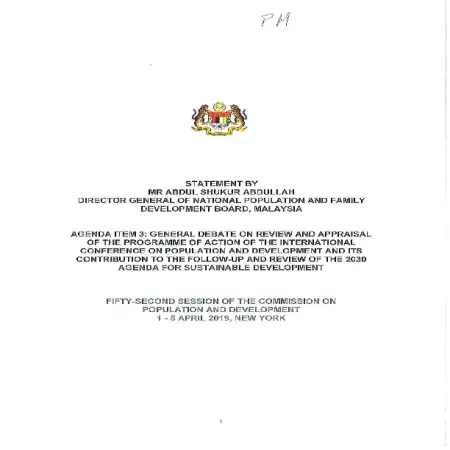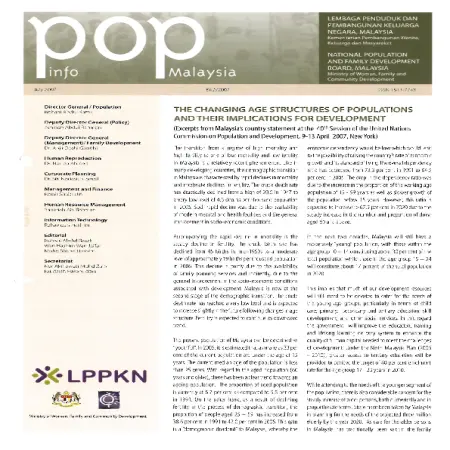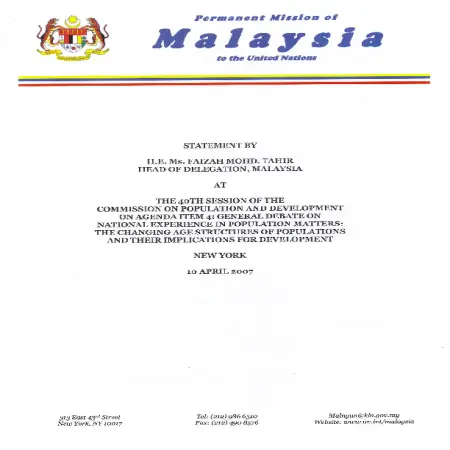Browse by Subject
Results for Search : "303 Social processes"
|
|
The 55th session of the Commission on Population and Development United Nations, New York, 25-29 April 2022
Item Type: Country Statement
Editor:
Year: 00/04/2022
Abstract: Malaysia’s socio-economic development has been significant in transforming our economy from a low income to an upper-middle-income status. We have achieved significant progress in eradicating poverty and narrowing inequalities. However, the COVID-19 crisis has resulted in vulnerable households falling into poverty and hardship.
|
|
|
|
|
|
The 52nd session of the commission on population and development:general debate on review and appraisal of the programme of action of the international conference on population and development and its contribution to the follow-up and review of the 2030 agenda for sustainable development
Item Type: Country Statement
Editor:
Year: 01/04/2019
Abstract: The population of Malaysia has increased more than three-fold from 10.5 million in 1970 to about 33 million today. the population was growing around 2.5 percent per annum for the period 1970-2000 but it has declined to 1.7 percent between 2010 and 2018.
|
|
|
|
|
|
The 51st session of the commission on population and development :general debate on sustainable cities, human mobility and international migration, New York
Item Type: Country Statement
Editor:
Year: 09/04/2018
Abstract: Malaysia has taken the initiatives to systematically coordinate sustainable urban planning and development, with emphasis on a balanced development; physically, environmentally, socially and economically, such as through the introduction of the Safe City Concept, and Go Green Kuala Lumpur Car-Free Morning.
|
|
|
|
|
|
The 49th session of the Commission on Population and Development on agenda item 4: general debate on national experience in population matters: "strengthening the demographic evidence base for the post - 2015 development agenda", New York
Item Type: Country Statement
Editor:
Year: 00/00/2016
Abstract: The Department of Statistics Malaysia (DOSM) has been responsible for undertaking the Population and Housing Censuses of Malaysia every years since 1970. The Census remains the main source of data collection aimed at providing a comprehensive set of statistical
information about the population in the country in terms of its size and spatial distribution, its demographic, social and economic characteristics as well as housing stock at a specific time
reference. The census provides essential information not only for policy development and planning, but also for managing, monitoring and evaluating programs and activities across a broad spectrum of sectors. The 2010 Census round utilized improved ICT technologies and new approaches in the different phases of the census operation. The emerging technologies are transforming the way the Census is conducted in terms of operations management, quality assurance, data capture, mapping (GIS, GPS), data processing and storage. With the ever increasing individual privacy and accessibility of internet, the e-Census was introduced in 2010. An internet based questionnaire for data collection, was found to be more effective to capture respondents mainly in large urban areas and the gated communities.
|
|
|
|
|
|
The 47th session of the Commission on Population and Development on agenda item 4: general debate on national experience in population matters: assessment of the status of implementation of the programme of action of the international conference on population and development, New York, 8 April 2014
Item Type: Country Statement
Editor:
Year: 08/04/2014
Abstract: Malaysia shares the view that the current state of the world’s population is one of unprecedented diversity and change, reflected in new patterns of fertility, mortality, migration, urbanisation and ageing. The continuation and consequences of these population trends will present both opportunities and challenges for the formulation and implementation of the post-2015 development agenda and for the achievement of all internationally agreed development goals.
|
|
|
|
|
|
The impact of Indonesian migrants from the locals' perception: a study in Sabah, Malaysia
Item Type: Scientific Poster
Editor:
Year: 00/08/2012
Abstract: Being a developed country, Malaysia has been receiving a large number of labour migrants from other neighboring countries. Statistics show that the total number of non-Malaysians in 2010 is 2.3 million compared to 1.3 million in the year 2000. It is over 8 percent of the total population in Malaysia and comprises mostly of Indonesian migrants. This phenomena has a great impact on Malaysia and its people. The objective of this study is to determine the impact of Indonesian migrants from the locals' perception and also to determine if gender, ethnicity, religion, marital status, educational level, job industry and monthly income make a difference in their perception. The data used for this study were obtained from the Study on Indonesian Migrants in Tawau, Sabah conducted by the National Population and Family Development Board (NPFDB) Malaysia in 2010. The survey managed to obtain information from 787 locals in Tawau. The dependent variable is the overall perception of the locals on the impact of the Indonesian migrants while the independent variables are gender, ethnicity, religion, marital status, educational level, job industry and monthly income. Independent t-test and analysis of variances (ANOVA) were applied to the data set. As a result, this study indicates that the locals in Tawau feel that the presence of the Indonesian migrants does have an effect on them. The mean score obtained was 95.053 out of a total of 135. The results of ANOVA showed that ethnicity (F = 6.950, df = 7), marital status (F = 12.320, df = 3), education level (F = 4.058, df = 7), job industry (F = 27.374, df = 3), and monthly income (F = 15.201, df = 6) contributed to the differences in the locals' perception on the impact of Indonesian migrants. Only gender and religion does not affect their perception. Thus, the entrance of Indonesian workers needs to be monitored as their presence are affecting the locals.
|
|
|
|
|
|
The changing age structures of populations and their implications for development
Item Type: Newsletter
Editor:
Year: 00/07/2007
Abstract: The demographic transition in Malaysia is characterized by rapid declines in mortality and moderate declines in fertility. Rapid decline in mortality was due to the availability of modern medical and health facilities and the general improvement in socio-economic condition. While, steady decline in fertility due to the availability of family planning services and indirectly, due to the general improvement in the socio-economic conditions associated with development.
|
|
|
|
|
|
The 40th session of the Commission on Population and Development on agenda item 4: general debate on national experience in population matters: the changing age structures of populations and their implications for development, New York, 10 April 2007
Item Type: Country Statement
Editor:
Year: 10/04/2007
Abstract: The transition from a regime of high mortality and high fertility to one of low mortality and low fertility in Malaysia is a relatively recent phenomenon. similar to the trends in many developing countries, the demographic transition in Malaysia is characterized by rapid declined in mortality and moderate declines in fertility. The crude death rate has drastically declines from a high of 20.0 in 1947 to a very low level of 4.5 deaths per thousand populations in 2006. Such a rapid declines was due to improvements in the health sectors and higher socio-economic development in the country.
|
|
|
|












